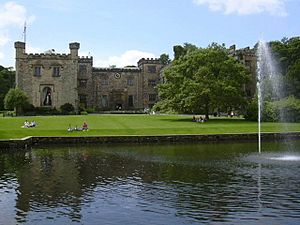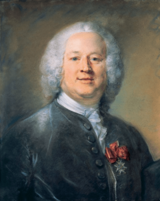Francis Towneley facts for kids
Quick facts for kids
Francis Towneley
|
|
|---|---|

Towneley Hall in Towneley Park, Burnley
|
|
| Born | 9 June 1709 Burnley |
| Died | 30 July 1746 (aged 37) Kennington Common, London |
| Buried |
St Pancras Old Church and Burnley, Lancashire
|
| Allegiance | |
| Years of service | 1728–1734, 1745-1746 |
| Rank | Colonel |
| Unit | Manchester Regiment |
| Battles/wars | War of the Polish Succession Philippsburg Jacobite Rising of 1745 Carlisle, December 1745 |
| Relations | John Towneley (1696-1782) |
Francis Towneley (born June 9, 1709 – died July 30, 1746) was an English Catholic. He supported the House of Stuart, a royal family that had lost the throne. People who supported the Stuarts were called Jacobites.
Francis served in the French army from 1728 to 1734. After this, he came back to England. He then joined the Jacobite Rising of 1745, a rebellion to put the Stuarts back on the throne. He became a colonel in the Manchester Regiment. This was the only major English group to join the rebellion. Francis was captured at Carlisle in December 1745. He was later found guilty of treason and executed in London in July 1746.
Contents
Who Was Francis Towneley?
Francis Towneley was born on June 9, 1709. He was the youngest of five children. His parents were Ursula Fermor and Charles Towneley. The family lived at Towneley Hall in Burnley, Lancashire.

The Towneley family was a well-known Roman Catholic family in Lancashire. Their private chapel was a main place for Catholic worship. Francis's family had a history of supporting the royal family. His great-grandfather fought for the King during the First English Civil War. He died in battle in 1644.
Francis's grandfather, Richard Towneley (1629-1707), was a scientist. He faced problems for being Catholic. He was even accused of trying to bring back James II in 1694.
Francis's father died in 1711. His older brother, Richard, was captured in the 1715 Jacobite Rising. He was found not guilty, but the trial cost the family a lot of money. Because of this family history, Francis was treated more strictly in 1745.
Like many English Catholics, Francis went to school in Douai, France. He joined the French army in 1728. He served until 1734. During this time, he helped the Duke of Berwick at the siege of Philippsburg in 1734. His brother John also spent time with the Jacobite court in Rome. He met Francis Strickland there, who later joined Prince Charles in Scotland in 1745.
Joining the Rebellion
Francis Towneley came back to Britain before 1743. He lived quietly in Wales. In late 1744, his French officer's role was renewed. This suggests he was chosen for an important part in any invasion. When he heard that Prince Charles had landed in Scotland in August 1745, he went to Manchester. He traveled with two Welsh Jacobite supporters, David Morgan and William Vaughan.
They met other Jacobite supporters in Didsbury. The poet John Byrom described Towneley as a "gallant soldier." He was very loyal to the Stuart cause.
Forming the Manchester Regiment
When the Jacobite army arrived in Manchester on November 28, Towneley and others formed the Manchester Regiment. This was the only major English group to join the rebellion in 1745. Many new soldiers were Catholic. However, most wealthy Catholic families did not join. The government had been trying to make Catholics more loyal. Joining the rebellion was a huge risk for them.
Towneley became a colonel. This was suggested by a French envoy, the Marquis d’Éguilles. Not everyone liked Towneley. He was known for being hot-tempered. One of his officers, James Bradshaw, even left his unit because of this.
The regiment received weapons on December 1. But they struggled to find more new soldiers. The Scottish Jacobites had agreed to invade only if they got strong English support. This support did not appear. So, at Derby on December 5, the Scots decided to retreat. Many English soldiers lost hope and left the army.
The Siege of Carlisle
By December 19, the Jacobites had retreated to Carlisle. They had captured Carlisle in November. Prince Charles wanted to keep it to show he planned to return. Towneley and his remaining 115 men volunteered to stay. They joined a group of 200 soldiers defending the castle.
The officers believed they could defend the castle well. They hoped to get good terms if they surrendered. However, when government forces arrived on December 22, supplies were low. Most Jacobite officers thought defending was useless. At Towneley's trial, a witness said he wanted to fight. He said it was "better to die by the sword" than surrender. But the other officers disagreed. The castle surrendered on December 30.
Some French-Irish soldiers escaped. The others were treated as prisoners of war. They were later exchanged. The Manchester Regiment soldiers were only promised their lives. This meant they would get a trial instead of being killed right away.
Trial and Execution
Towneley was taken to London with other prisoners. He was held in Newgate Prison. He reportedly kept to himself. He continued to argue with John Hamilton, another prisoner.
The authorities carefully checked claims that prisoners should be treated as prisoners of war. Towneley's claim that his French military role protected him was not accepted. He was tried on July 13, 1746. He was found guilty of treason. This meant he was guilty of betraying his country. He was sentenced to be executed.
Francis Towneley was executed at Kennington Common on July 30, 1746. Eight other officers from the Manchester Regiment were also executed that day. These included George Fletcher, David Morgan, and Thomas Deacon. Francis was described as calm and dignified. He wore a black velvet suit made for the occasion.
His body was buried at St Pancras Old Church in London. This was one of the few places in London for Catholic burials. His head, along with George Fletcher's, was placed on a pole at Temple Bar. A journalist reported that friends of his nephew later removed it. A descendant, Katherine Grant, says the relic was returned to his wife Mary. It was kept in the family chapel. In the 1930s, it was moved to a bank. Later, in the 1940s, it was buried at St Peter's Church, Burnley.
Images for kids
-
Towneley Hall in Towneley Park, Burnley
-
Francis Towneley's older brother John, who was also involved in the 1745 rising.



